(VOVworld) - “Xam” singing is a traditional art form which originated in Vietnam’s northern regions. As its deep lyrics narrate daily life stories, the art form has been considered to be the nation’s delicate cultural item, and has become an important part of the Vietnamese people’s spiritual life. For a long time, the art-form fell into oblivion and faced a great risk of being lost, but recently it has been revitalized and gradually proved its vital place in Vietnamese people’s minds. VOV’s Viet Anh finds out more about this traditional art form.
Back to the 13th century, there was a tale about a prince who met a fairy, who gave him a magic instrument and taught him how to play and sing the most delightful way that normal people couldn’t equal. The so kind-hearted Prince later taught the music to his citizens to help them deal with the hardships of life. The music that comforted people was Xam singing. Culture researcher and composer Thao Giang, Deputy Director of the Vietnam Traditional Music Development Center, has studied Vietnamese folk music and Xam singing for more than 40 years. He elaborated on the origins of the art form: “Xam has existed for over 700 years. The legend says that Xam singing was invented by Prince Tran Quoc Dinh, during the Tran dynasty. The genre has ancient historical meaning as each song is a story about Vietnamese people’s aesthetic features, ethical education, and lives. Nowadays, Xam not only appears in folk performances, lullabies, music for funerals, but also in drama, films, circus performances, and proves that the genre has now revived and leaves an impression on people’s minds.”
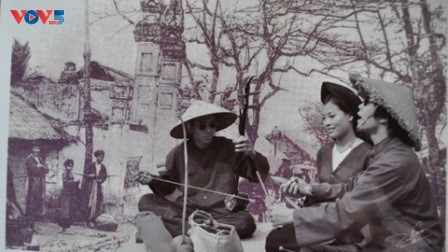 |
| In the past, Xam singing was considered to be the art of the poor only. Xam artists, who were mainly blind, not only sang; they poured their hearts out when they performed as the songs featured their truly sad stories (Source: VOVworld) |
In the past, Xam singing was not only performed at crowded trams, car stations, markets and street corners, but also at important events like weddings, funerals, death anniversaries, thus, there were available different types of Xam songs to fit the events and environment. Duc Huy, a Xam artist at the Vietnam Traditional Music Development Center, tells you how to distinguish some of the main tunes in Xam songs. "Xam singing is very diverse in its style and performance environments. In the past, “Xam tau dien” or “tram xam”, a unique Xam singing style was performed on crowded trains or car stations. The trams became ideal stages for artists to tell their stories through the melodies of the songs. “Xam cho” is a kind of “xam” singing performed at the market place to catch people’s attention. Although the markets were noisy, the sound of Xam songs was heard because of the drum’s strong beats and unique melodies. And, “Xam sai”, which is a little bit enigmatic and mystical, is performed at worshiping ceremonies.”
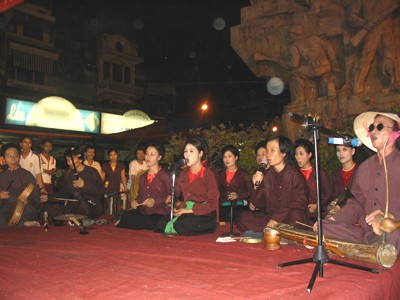 |
Xam singing is rooted in Vietnamese’s northern region. The melodies are very close to the people and easy to learn as each song is a small story, associated with people’s daily lives
(Source: Quehuongonline) |
Among the traditional Vietnamese art forms, Xam is something very simple, natural and familiar in people’s lives. Xam songs are diverse in content, but all praise love and human values, so it’s loved and treasured by all. Xam artists should have a very powerful voice, to sing continuously for hours without the support of techniques. Duc Huy says: “In Xam singing, the artists use a special hearty voice called “Bach thanh”. The technique requires them to push out a lot of air and power from their abdomens, thus, creating a very strong, powerful, and clear voice. The musical instruments used in Xam singing are diverse, including a monochord, two-string violin, drum, bamboo tocsin, castanets, and so on. In my opinion, Xam might be one of the most familiar art forms as it tells the daily stories though clever, attractive, and easy-to-remember music”
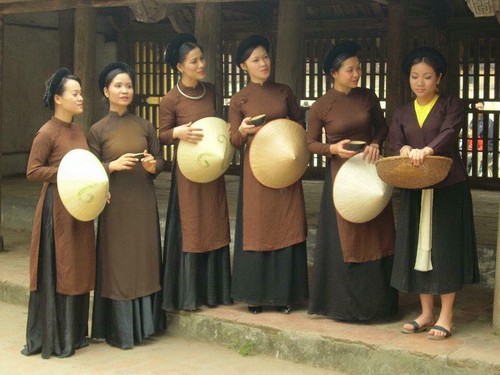 |
The female artists from the Vietnam traditional music development center
(Source: the center's FB) |
In the past, Xam singing was considered to be the art of the poor only. Xam artists, who were mainly blind, not only sang; they poured their hearts out when they performed as the songs featured their truly sad stories. That’s one reason why the art form became so attractive and earned the empathy of its listeners. Researcher Thao Giang talked about the Xam singing’s prominent characters in the past, and about effective ways to revive the art. “Xam singing is rooted in Vietnamese’s northern region. The melodies are very close to the people and easy to learn as each song is a small story, associated with people’s daily lives. In the past, the news was instantly turned into a song by Xam artists and then started to spread around town. Thus, Xam was considered as one of the fastest way to spread information. When on stage, the artists not only sang, they performed to attract audiences, which made the shows more realistic than ever. When reviving this art form, we always try our best to maintain those original colors to bring to listeners its core values.”
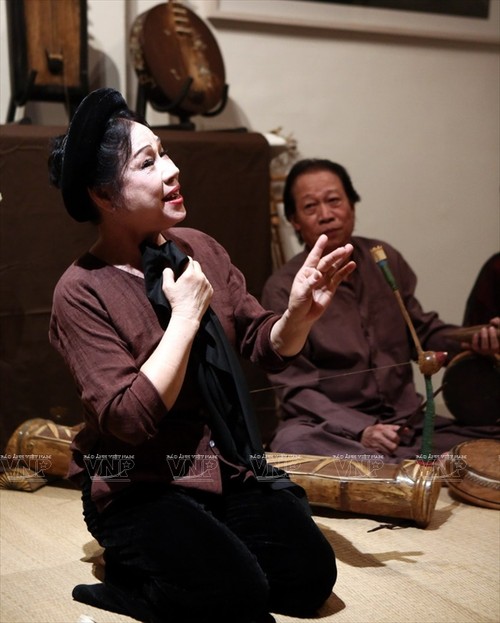 |
| Xam artists should have a very powerful voice, to sing continuously for hours without the support of techniques (Source: VNA) |
While many folk art genres are dying out, Xam singing can still find its way back and prove its place in the music market. The genre has its own beauty, in its tones and rhythms, which are so attractive and gorgeous. Thao Giang again. “Xam singing has attracted more and more audiences. Unlike other types of traditional arts, for example, “Chau Van” (Vietnamese ritual singing), which is usually performed in temples or pagodas, and “Trong quan” folk singing, which is often found in village festivals, “Xam” singing can be performed anywhere, from the Opera House to any street or corner where large numbers of people pass. Xam attract audiences from many walks of life because its lyrics are rich in genres and diverse in term of content”
Nguyen Van Bon from Ha noi is a loyal fan of the art. When Bon was young, he used to listen to Xam songs on the trams or in the markets; thus, the images of the Xam artists are still fresh on his memory. “I used to listen to Xam singing in 1960s and 1970s. The Xam melodies and the sound of the streetcars’ bells became imprinted in my mind and soul. Nowadays, it seems like the younger generation like listening to modern music like jazz, rap, and rock. However, the old like me are still attached to the kind of traditional music like Xam to recall an image of Hanoi in the past and remember ancient values as well.”
Xam singing can beguile everyone. You wanna listen to it? Let me show you
Coming up next is another Xam song, by To Minh Cuong featuring Thu Phuong
To create opportunities for the peple to learn and find inspiration from traditional Vietnamese values, NGOs and projects have been cooperating to revive Xam. Le Xuan Phong, is a member of “I Move”, a social media project encouraging youths to further their understanding of traditional values.“In some periods, the art became in danger due to the wrong beliefs that Xam was the singing style of the blind or beggars only. Moreover, there appeared a lot of parody versions of the original Xam songs on the internet, thus, audiences somehow formed a misunderstanding of the art form. Recently, following practical activities reviving songs like “Spring Night 2016”, and performances at Dong Xuan night market, more and more people have been attracted to the genre. The NGOs working in cultural protection, along with researchers have made big efforts to recover Xam documents to provide audiences with deeper understanding of Xam singing and bring them closer to the art form”
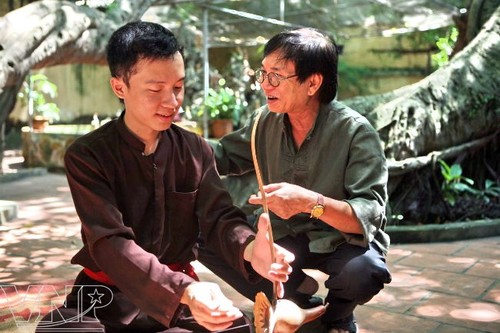 |
| While many folk art genres are dying out, Xam singing can still find its way back and prove its place in the music market (Source: VNA) |
Many classes in Xam singing have opened, helping music lovers enter the world of a modest genre of traditional music that is so filled with love, appreciation and joy. Xam singing is not easy to learn, but anyone can try. With passion and love, anyone can learn, no matter how old they are. Artist Duc Huy told us: “In my opinion, Xam can be considered as the most simple and natural art form reflecting life truthfully. Many Xam songs are still preserved, suitable for all ages, genders, and people from all walks of life. So, with passion and patience, everybody can experience the art form.”
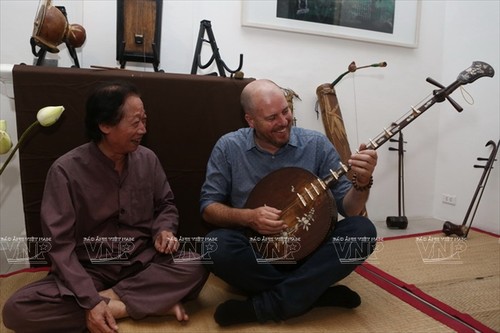 |
Many classes and workshops in Xam singing have opened, helping music lovers enter the world of a modest genre of traditional music that is so filled with love, appreciation and joy
(Source: VNA) |
Nowadays, Xam is considered an endangered traditional form because the experienced artists growing older. There have been several efforts to preserve and propagate the art form, for example Xam Night at Dong Xuan market and Xam introduction workshops. However, it is a good sign that, amid the variety of so many modern musical genres, the younger generation hasn’t turned their backs on traditional art forms. They still nurture love, appreciate and uphold the beauty of the country’s cultural treasure. Researcher Thao Giang is hopeful: “I feel so proud that Vietnam’s younger generation now pays more attention to the Xam genre. Some people say that the youths now turn their backs on traditional art forms as well as traditional values. But I think it’s totally wrong. The most eloquent example is the success of the Xam show in the Old Quartet every week. The support from audiences promises a revival of the folk art genre and motivates Xam artists to contribute to the preservation and promotion of the art to the public.”
This week, we’ve been talking about traditional Xam singing. We welcome your feedback at: English section, VOVworld, Radio Voice of Vietnam, 45 Ba Trieu Street, Hanoi, Vietnam. Or you can email us at: englishsection@vov.org.vn. Tune in to our English program on the Internet at vovworld.vn. Good bye. See you next time.